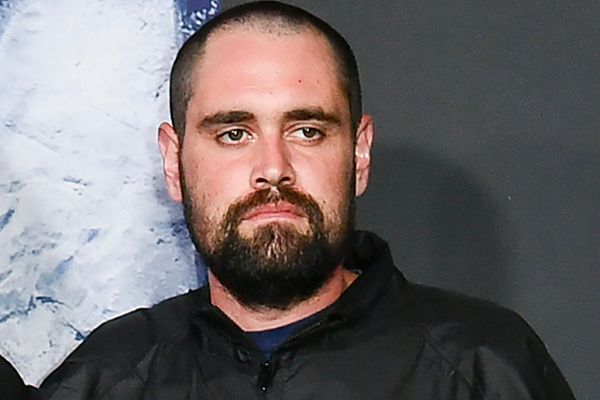
“Capital is dead labour, which, vampire-like, lives only by sucking living labour, and lives the more, the more labour it sucks,” Karl Marx wrote in Das Kapital. More than a century later, his indictment on capitalism rings truer than ever – and the Malthouse’s new production takes it very literally.
Playwright Keziah Warner’s adaptation of Nosferatu, the classic 1922 silent film (itself an unofficial adaptation of Bram Stoker’s novel Dracula), leans right into the metaphor. This version, directed by Bridget Balodis, is set in Bluewater, a fictional Tasmanian mining town on the brink of environmental and economic collapse. Mayor Knock (Max Brown) and his underling Tom (Keegan Joyce) are running out of ideas on how to save the town – until they receive a mysterious letter from Count Orlok (Jacob Collins-Levy), a mainland billionaire with the resources and goodwill to reinvigorate the local economy through vineyards.
Local doctor Kate (Sophie Ross) and astute journalist Ellen (Shamita Siva) are more wary than the eager men about this too-good-to-be-true interloper. Naturally, things start getting hairy as Orlok sinks his fangs into the town – sure, the economy is booming, but what’s with all the missing townsfolk?

Warner’s take on the gothic genre has an injection of the contemporary, her script flitting between dramatic and surprisingly comedic, the latter often in quippy one-liners. The production has fun with the campiness of the vampire figure – one climactic scene has a cheeky word-for-word snippet from a certain shlocky cinematic franchise; music from the theatrical goth band Bauhaus plays before and after the show, and Collins-Levy appears sometimes in gaudy costume. This playful self-awareness provides levity from the psychological intensity of the play, but can create a feeling of whiplash when the two interchange both quickly and frequently.
Romanie Harper’s set is simple but effective: a patterned carpet and single table is backdropped by a row of six ominous, illuminated doors, which open to reveal different settings: a hospital room, a closed-off dirt prison. It allows the actors to move between scenes with ease, while also providing a relevant rhythm: the doors swing open and shut like a cog in a machine. Impressive special effects abound: vines shoot from the ground, rainwater turns into blood, shadows morph into the inhuman and grotesque. A body-switch moment happens so seamlessly that it’s a genuine, thrilling shock, and Kelly Ryall’s eerie sound design adds to the foreboding atmosphere.
There are some striking hints of religious symbolism: in one memorable scene, all five cast members sit around a table à la The Last Supper, animating in turn as Orlok sits in the middle, still and Christ-like. This scene, and the one in which Orlok and Tom first meet, plays out like choreography, with wonderful synchronicity between the actors as they ping-pong the rapid-fire dialogue.

Indeed, interpersonal matters outside of the trouble with Orlok (Knock and Kate are childhood sweethearts tentatively reconciling, Tom and Ellen are romantic partners with a professional conflict of interest) provide a humanity that counteracts the destruction playing out in the town.
On opening night, there might be a slight case of the jitters: both Brown and Siva are a little stiff at first, but visibly relax into their roles as the show goes on. Siva taps into a determined steeliness particularly in the second half, cutting to the journalist’s noble mission for truth and justice – then she switches up, revealing that even the righteous can crack in the fight for power.
Collins-Levy’s performance is equally charismatic and terrifying, but his accent distractingly changes: at times prim and English, at others broadly Australian. Joyce, best-known as the anxious Arnold from Josh Thomas’s series Please Like Me, plays the similarly nervy Tom with furtive glances; Brown leans into Knock’s descent into madness with a wild, unhinged edge; and Ross as Kate gives a performance that wouldn’t be out of place in a classic Australian small-town drama, leading with an emotional, tightly controlled monologue. These characters simultaneously play into and skewer stereotypes, but some are more convincing than others in both design and execution.
The build is slow and delicious as Orlok’s reign of terror continues: it’s the kind of grip-your-seat suspense that makes live theatre so exciting. As it heads towards its denouement, though, Nosferatu loses its footing. There are several points where it seems as though the play is over, but then it keeps going, so when it actually does end – on a cliffhanger, no less – it feels anticlimactic. This uneven pacing is what lets the production down the most – it tries to do, and be, a lot of things, but not all of it lands.
Still, the cast and audience alike are having a blast. The metaphor is about as subtle as a stake in the heart, but if there’s one thing to take away, in parlance both modern and literal: capitalism sucks.
Nosferatu is on at the Malthouse Theatre in Melbourne until 5 March







